Fen Huang1, Zhi Min Jin2
1College of Art and Design, Zhejiang Agriculture and Forestry University, Hangzhou, P. R. China
2College of Pharmaceutical Sciences, Zhejiang University of Technology, Hangzhou, P. R. China
Correspondence to: Fen Huang, College of Art and Design, Zhejiang Agriculture and Forestry University, Hangzhou, P. R. China.
| Email: |  |
Copyright © 2023 The Author(s). Published by Scientific & Academic Publishing.
This work is licensed under the Creative Commons Attribution International License (CC BY).
http://creativecommons.org/licenses/by/4.0/

Abstract
The Han Dynasty image included various recreational scenes such as confrontational drama, athletics, VarietyShows accompanied by song and dance, games, mental tournament, its expression style was either true portrayal or boldly artistic fiction. There was a special kind recreational images which was related gods in the heaven and people on earth, and variety of mythical monsters and creatures. This kind of recreation went gradually away from the recreational origin, finally transformed into fairy style in constructing a beautiful fairyland where the earth and the heaven, ancient and modern world, people and God, virtue and reality are merged in to one. Generally, recreational images of the Han era reflected broad and inclusive, vigorous yet supple characters of the Han Dynasty people, confirmed their leisurely and carefree lives, showed their extremely flying imagination, embodied their Taoist’s romantic ethos of amusing themselves to death.
Keywords:
Recreation, The Han Dynasty image, Ethos, China
Cite this paper: Fen Huang, Zhi Min Jin, The Ethos Viewed from the Recreational Image of the Han Dynasty of China, Archaeology, Vol. 10 No. 1, 2023, pp. 1-9. doi: 10.5923/j.archaeology.20231001.01.
1. Introduction
In the Han Dynasties (206 BC-AD 220), the nation was unified, the economy was developed, the people enjoyed relatively stable lives, all the factors promoted the development of recreational activities to be in vogue, such as confrontations, athletics, board game, Variety Show, pastimes and so on. In this article, the recreational image of the Han Dynasty are collected from the source of tomb stone engravings, tomb frescoes, and some pictures draw in mortuary objects or in ancestral cenotaphs. These images were related to the burials, and were the products of proper burial rites.Recreation is originated from normal human activities such as work, social activities, competitions, however, it is detached from the original track of development, with main purpose to meet the needs of amusement, and it is incorporated different artificial factor such as exaggeration, distortion, emotion and so on. The recreational images of the Han Dynasty were rich and diverse in format, there were not only real scene description, but also bold artistic fiction. Further more there were a special class regarding immortal theme, where the recreational theme would be seen just as the connotation of being immortal was removed.Recreation activities are usually the most direct portrayal of human spirit. Modern scholar Lin Yütang had once said: “if we did not know the people's daily recreation, we cannot know the nationality. if we did not know how the individual do in the spare time, we could not be regarded as the persons who have been familiar with him.” The overall recreational picture of the Han era reflected broad and inclusive, vigorous yet supple characters of the Han Dynasty people, confirmed their leisurely and carefree lives, also reflected people’s enthusiasm for lives, and the infinite yearning to wonderland. In the Han era, Buddhism was just introduced but still have no overall influence on the local culture, the mental qualities described above embodied the pure Chinese flavor. Hereafter, the spirits are discussed in detail.
2. Ethos Combining Both Vigor and Suppleness
The Han dynasty was born from the war at the end of Qin Dynasty, the nation inherited naturally the martial spirit of previous generations, and took confronting athletics as part of practicing warrior-ship. The confronts included animal taming, beast fighting, which was stemmed at fighting show of pre-Qin dynasty; the athletics included horsemanship, archery, hunting, Cuju (an ancient Chinese game of kicking a ball). Either in confronting or athletics, the player must resort to skills and tactics to win the game in different degree, except by mere strength. In the competitive game image, deep strength and power was shown usually by the exaggerated motion; mean while, entertainment, theatrics, skills were shown by fast conversion from point, line to plane. The Han Dynasty and the Rome Empire existed in the Eastern and Western hemisphere almost at the same period, coincidentally fighting game were both popular in the two reigns. The events of fight competition would make the empire to remain in a high state of readiness to military affair, massive athletic activities was also of significance in troop inspection and manoeuvre. In the early decades of the Han era, officials and populace might all take parts in fighting game between man and beast. However, to the Eastern Han era, fighters drawn in pictorial stone were almost the lower civilians who were usually dressed in short cloth, didn’t wear hat and their upper body were naked, while the nobles appeared as the appreciator in the hall. Focus of confronting fight activities of the Han era was led on entertainment and skills, emphasis was placed on the player’s own experience. Therefore, the young or the old, the weak or the strong, all might participated in it personally. Ancient Roman was famous in the world for combating game, just as inscription on a remnant of ancient Roman wall "the life is hunting, going into the beach, watching duel, pursuing pleasure". In contrast to Han dynasty, in the combat of ancient Roman, gladiators were all most slaves, and the fighting was carried out between person and person [1]. In the painting of confrontational fighting on silk (Fig. 1), standing on the ground, two long-hatted fighters were angry with their eyes gazing at each other, to be eager for a fight. It was just at the time of jump for fight. At left side, the bystander, with sleeve turned over, might be the referee. Some confrontational fighting between persons evolved later into performing acrobatic art, this was portrayed remarkably in a fencing image. In the image of dancing with sword (Fig. 2), two swordsmen fought with each other, one swordsmen wielded a sword to click the opponent gently, another swordsmen responded in a dancing movement with his limb outstretched and his long sleeves flying. At left side two standees were talking seemingly, at right side a person held a sword and another one fell down to the ground with a mallet shield held in his hand. As a contrast, the procedure of ancient Rome gladiatorial game were more fixed than that of the Han Dynasty, the scale was larger, the outcome was needed for referee to judge, the gladiator took deliberately more normal physique and physical fitness as their pursue (Fig. 3) [2]. | Figure 1. Fencing (painting on silk unearthed from Galleria Borghese, the Ø symbol marks a gladiator killed) |
 | Figure 2. Dancing with sword (stone engraving unearthed from Longxi village, Nanyang County, Henan Province) |
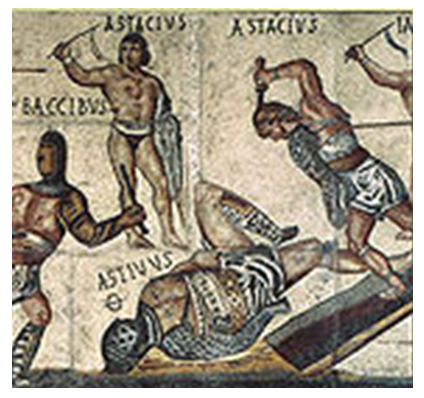 | Figure 3. Ancient Rome gladiator (mosaic unearthed from tomb at Jinqueshan, Linyi, Shandong Province) |
From the the Western to the Eastern Han era, animal-fighting changed gradually to the beast-taming, where the former players resorted mainly to courage and power and the latter always to skill and wisdom. In a image of viewing dental inside tiger mouth (Fig. 4), the Hu (the northern barbarian tribes in ancient China) valiant fought two tiger by himself own, with his upper body naked and bent; he stepped and kicked the tiger, outstretched his hands and opened the tiger’s mouth to observe its teeth seemingly. The image demonstrated a kind of supernatural power. With the time passed, fighters begun to imitate animal’s appearance, action, power, the bloody fighting contents was removed progressively, therefor in the final animal fighting was transformed finally into a kind of recreational activities. Correspondingly, the fierce beast appearance, which was usually represented by Taotie (a mythical ferocious animal) since the former three dynasties, disappeared gradually, and became to be auspicious and mild signs. Image of "Old Man Huang of the Eastern Sea (Fig. 5)" described soothingly the core scene of a programmed tiger-fighting story which started from Old Man Huang beating the tiger, ended at the moment when he was drunk and killed by the tiger [3]. In the game, two actors played in accordance with scheduled plot, one acted as tiger, another acted as Old Man Huang who had the action of taking knife to pray, and dancing. The game was slightly sarcastic, and was scheduled with conflicts, beginning and ending. Different from images of Hu and Old Man Huang, the picture of warrior encountering tiger was an unreal scene (Fig. 6). In the image, a warrior fight a jumping tiger with hands, a winged immortal held tiger neck and slide on the top of the tiger’s back, two fairy birds shuttled among them. What the picture told us was that, the man were intimated with the beast, being not in a confound state, but in a playful comfort. This was the imaginary product resulted from the Taoism influence.  | Figure 4. Viewing dental inside tiger mouth (stone engraving unearthed from Fangcheng, Henan Province) |
 | Figure 5. Old Man Huang fighting tiger |
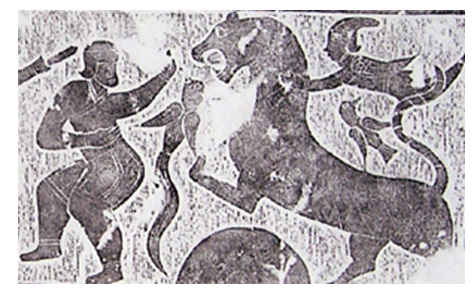 | Figure 6. Warrior fighting tiger (tomb stone engaving unearthed from Jiaxiang, Shandong Province [4]) |
Horsemanship was originated in the Xia and Shang dynasties [5], the Chinese literal nomenclature for it appeared most early in the Han era in the Discourses on Salt and Iron. In horsemanship image in the broken lacquer mirror case, an equestrian stood on and balanced with his single leg on a horse in gallop, with his body leaning forward and his long sleeve flowing, he displayed wonderful feats, calm and steady movement (Fig. 7). A stone engraving at Confucius Temple depicted a group of horsemen performing stunts (Fig. 8). An equestrian rode on a horse in gallop with hands outstretched, followed by a horse-drawn chariot. Three equestrians demonstrate incredible feat of flight towards the rider one after another. One stretched out his arms to catch hold of the rider’s hand, another took hold of the horse tail, and the third grasp the mane of the horse pulling chariot. Close behind the fast running chariot was a man making efforts to jump onto it. Fig. 7 was a realistic outcome, as a contrast, Fig. 8 was a completely fictitious product.  | Figure 7. Horsemanship (decoration in lacquer mirror case unearthed from Xianyang, Shaanxi Province) |
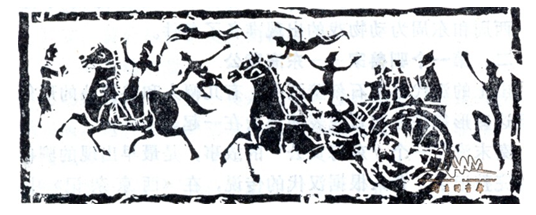 | Figure 8. Equestrians performing stunts (stone engraving unearthed from Confucius Temple, Shandong Province) |
Archery was performed as a kind rituals to symbolize and reinforce the aristocratic hierarchy in the Zhou Dynasty, and it was accompanied usually by ceremonial music and wine. In these rituals, shooting with proper form and conduct was often more important than simply hitting the target. Later in the Han dynasty, the ritual archery developed into competitive one, where the archers were often skillful but brash. In the Han dynasty, mounted archery (shooting on horseback, or horseback archery) became popular recreation among the folk, and were took as a prevalent way of hunting and a major form of entertainment. [6] In the social background, hunting image was seen often in the engraved stones. In a mounted archery engraving on tomb stone unearthed from Zhengzhou, a deer run at a full speed with limbs and the body almost pulled into a straight line, followed closely behind by a shooter who ensconced stably in a galloping horse and showed excellent riding and shooting skill, with the his upper body leaning forward, his left hand holding bow and his right hand pulling over string. In a cloud chart of hunting (Fig. 9), bird and animal contours were outlined with arc line in a manner of freehand brushwork, it looked like cyclone cloud shuttling, changing unpredictably. This image is very unique among many similar artwork. The Han Dynasty peoples attached more importance to Watching Gas [7], the cloud chart was just the product of it. | Figure 9. Cloud chart of hunting (tomb stone engaving unearthed from Suide, Shaanxi Province) |
Cuju is to play the ball with feet, here Cu means kicking with feet, and Ju refers to a kind of leather ball stuffed with feather or wool. Either single or a group of persons might participate in the game. The game might be accompanied by music, showing great skill and mansuetude; or it might be a sheer style of athletics, demonstrating strength, which was close to the modern football. All the people of Han Dynasty, from the northern to the southern, from the royal family and nobles to the common people, liked Cuju game, just as described the work of Discourses on Salt and Iron: "while galloping in broad roads, playing Cuju in small corners." In a stone engraving of Cuju in a watchtower, a high hair bun woman jumped up highly to kick the ball, dancing with her long sleeve flying lightly (Fig. 10). On both sides, one person stood on the ground and beaten drum for accompaniment. The portrait was true to life likeness, the player was seemingly ready to come out at one's call. It was the earliest Cuju image of real object found, and might be took as a physical evidence of China as the birthplace of football [8]. 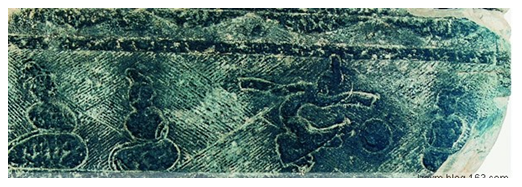 | Figure 10. Woman playing Cuju and dancing with the music (Qimu Que Gate, Songshan, Henan Province) |
3. Broad and Inclusive Spirit
Compared with the previous three generations, the Han Dynasty culture tended maximally to popularity, plebification and entertainment, opening a new period of incorporation of officials and civilians. This was because, at the beginning of the Han Dynasty, most of the upper-class elites were born as civilian, and had various natural connections with common people. In addition, with the enlargement of territorial border, various external cultures came in a continuous stream. Moreover, the establishment of Yüefu (national music bureau for collecting folk songs and ballads) promoted a large number of folk music and dance to be performed at imperial court, jus as described in Yuefu Poems (volume 53) "various folk musics appeared since the Zhou Dynasty, due to augmenting in contents at the Qin and Han era, not all of the play at banquet was elegant." Variety Shows was originated from confrontational drama which was developed in pre-Qin eras. In this situation, with the recreational contents added in it massively, such as interest, teasing and dramatic, Variety Show expanded unprecedentedly, and finally became an inclusive recreational form. In the Han Dynasty, Variety Shows covered fighting, singing and dancing, acrobatics, magics, masked characters and burlesques. Notably, in Han dynasty, Variety Show were frequent in program, complicated in content, diverse in art species, but music and dance were accompanied with the performances throughout. In the Han Dynasties, the relatively stable social existence for more than 400 years, additionally, the popularity of cattle farming and the application of iron resulted in high labor return rate. Therefore, customs of "being fond of farming, servicing agriculture" was brew gradually, and a large number of social wealth was accumulated. Subsequently, reckless pleasure-seeking became a common practice. Variety Show was soon merged with feast gradually, and was generally demonstrated in folk at minor events such as weddings and funerals, and in the great events such as hilarious at temple festivals, and even in the imperial feast ceremony. In the Eastern Han era, powerful nobles annexed large amount land, creating a large number of self-contained manors of "city within a closed door", providing excellent places for Variety Show performances. The fresco of Variety Show accompanied with feast depicted the tomb owner’s antecedents from Xiaolian (the filial and incorrupt standard of nominating civil officers) to career peak of colonel (Fig. 11). The fresco showed the scene of host arranging feast for guest, where there were a variety of performances, such as dancing, horn-blowing, playing stick, ball-jumping, disc-dancing, and so on.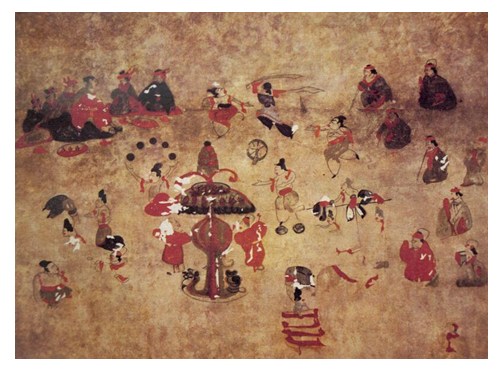 | Figure 11. Feast and Variety Show (tomb stone fresco unearthed from Helingeer, Inner Mongolia, Later East Han Dynasty) |
At the beginning of the Western Han era, with the development of Variety Show, the aesthetic style for vulgarness came in vogue. This situation was fully annotated in the burlesque. In the Han era, burlesque was displayed often with Variety Show in the same stage, the performer was called as Paiyou, who were acted usually by gnome of low social status, and who were skillful in cracking joke and teasing, similar to the clown in modern drama. The figurine depicted a large headed Paiyou siting on the ground, with his chest and belly naked, and waist barefooted, forehead wrinkled (Fig. 12). He wore loose trousers, held a circular drum with one hand and raised a hammer with another. The Paiyou was elated to the degree of forgetting himself, dancing with joy unconsciously, and was excited with exaggerated expression, mouth grinned, face smiling, as if into the climax. The comedian showed us of his performing experience of the hardships of life, and his complex mentality of enjoying life though hard up. | Figure 12. Gray Paiyou of storytelling and ballad-singing (unearthed from Tianhuishan cliff tomb, Chengdu, Sichuan Province, dating of Eastern Han Dynasty) |
The Han dynasty held the policy of opening to the outside world. In addition to the successional reclamation of traditional entertainment, various foreign acrobatic arts were also merged, such as Central Asia, West Asia, Persian, Rome Empire, Hindu, Southeast Asia. These images of Variety Show included pole climbing and tightrope from Southeast Asia, overlapping props then climbing from ancient Persia. The stone engraving (Fig. 13) showed performances including handstands, flying balls, jumping sword, throwing down, hanging, disc rotating, tightrope-walking, and horse show, leopard show, dragon show, fish show. What is deserved to be mentioned especially is that, in this picture, everywhere man and animals coexist in sports and entertainment, with more than 50 peoples and animals on the same stage, such as dragon, phoenix, leopard, up to more than 10 species of fish and other animals. The scene looked warm, peaceful and spectacular, it was rare in real life. It is a typical example of the thinking that all creatures are equal, and the harmony of the universe. | Figure 13. Song and dance in Variety Show (tomb stone engaving unearthed from Beizai Village, Yinan, Shandong, Province) |
4. Leisurely and Carefree Lives
In the Han Dynasty, the factors of social stability and economic booming promoted the board games and pastimes in the course of being generated, developed and prosperous, also resulted in a greed custom of seeking nothing but profits, and of desiring for pleasure. The board game mainly included chess, Dang Chess, Liubo, in which military defense array was simulated somewhat, the main purpose was to exercise thinking and to edify personal disposition [9]. It became soon the fashion to a degree of "indulging in board games, with industrious intention casted aside, with food and sleep forgotten, from whole day till night that is lightened with candle". The pastime included arrow-casting, guessing-cover, hiding-hook, bird-fighting, which was predominantly performed at the party, banquet and leisure venues, with purpose to entertain people originally, to edify and adjust spirit, and to cultivate the mind, also to obtain mental and physical pleasure. The board game and pastime were often accompanied by advisement for unwilling drinking, where the loser in match must drink more than he need, and in the later time money was designed deliberately for fought for, then such activities were transduced to be a sort of complete gambling.Weiqi was also called Yi in the Han era, it was considered the epitome of the Chinese will and wisdom, embodying mathematics, stratagem and philosophy. At that time it was popular with the literati class and aristocracy. Tang Chess appeared in the later period of the Western Han Dynasty, and become popular at Eastern Han Dynasty. Tang Chess are different from other chess games with board, focusing to the skills and techniques. The stone carving of chess of the Han Dynasty (unearthed from Zaozhuang, Shandong) verified the records of history documents. Liubo was another board game in ancient China, dated much earlier than Chinese Chess, and it is immensely popular during the latter period of the Warring States and throughout the Han dynasty and even in the Sui and Tang Dynasties [10]. In the Historical Records . Jesters, it is recorded as "in town men and women sit miscellaneously, they are detained in drinking wine, in playing Liubo and arrow-casting." Liubo was popular from the Spring and Autumn period to the Qin and Han dynasties, and had become an indispensable item in the daily life of the time. The Han Dynasty bronze mirror with rule pattern (or known as " Liubo chessboard bronze mirror") was designed by mimicing Liubo chessboard pattern decoration, which reflected popularity of Liubo. The six pictures of Liubo (Fig. 14) showed vividly the whole process, namely, sitting, casting chopsticks, playing chess, drinking. This was a chess game that was featured by puzzling the player, and making them to pay attention to internal and external harmony between body and mind. | Figure 14. Playing Liùbó and drinking (tomb stone engraving unearthed from Mizhi, Shaanxi, Province) |
By Touhu (Game of Pitch-Pot), it is referred to cast arrow of no shaft into the flask. Touhu was developed from the pre-Qin periods, as a game of projection derived from archery rituals of Western Zhou dynasty [11]. At late decades of Spring and Autumn period, aristocrats declined progressively, many of them were not able to open bow, therefore archery rituals couldn't be carried out normally, then turned to be Game of Pitch-Pot. Being the less cerebral in nature, it was commonly played as a drinking game among nobles and scholars during banquets in the Han Dynasty [12]. Right the middle of in a Touhu image (Fig. 15), the host and guest sit oppositely, they were holding some arrows, trying to cast them into the pot. There was a zun (wine vessel) put between them, two arrows were in the pot while a spoon was in the zun. One thrower wore a conical cap, another wore a crown, they were all dressed in long cloth. At left side, sitting on ground and being handed by a servant, an person seemed to be intoxicated due to be made to drink as a forfeit; while a person sit on the right side, he seemed to be an onlooker, or a judger.  | Figure 15. Drinking and Game of Pitch-Pot (tomb stone engraving unearthed from Nanyang, Henan, Province) |
In recreational images of the Han Dynasty, beside fight between man and beast, between beast and beast, which was more cruel and tragic, there were scenes of fight between small animal, such as cockfighting, duck-fighting, etc.. In a cockfight picture of engraved brick (Fig. 16), two roosters fought against each other with their neck tangled, as if at the inextricable time, two long-hatted players stood by at each side, waving their arms, seemed to cheer in crying, also seemed to scold each other. The picture expressed a thrillingly conflicting atmosphere. The picture described rather the playful quarreling between persons than the exciting cockfight. In the Han era, with the rise of commercial city, various game became popular in the society, such as the Liubo and cockfight. Usually, such games contained a lot of practices of betting, therefore might result in interpersonal conflicts, and even caused lawsuit. | Figure 16. Cockfighting (tomb brick engaving unearthed from Zhengzhou, Henan, Province) |
5. Amusing Themselves to Death
There were plenty of recreational images of the Han Dynasty, which were draw in realistic or in artistic manner. Also, there were various scenes with connotation drifting away eventually from the recreational origin by sake of Taoism influence, they might be related to Gods in the heaven and monsters on the nether world, or to mythical creatures in mind and real earthlings in daily life. Finally, these scenes transformed into fairy style in constructing the beautiful wonderland where ancient and modern world, people and God were unified into one. Taoist thinks people may be ever-young and healthy through practices of taking pills of immortality and of cultivating vital energy, and finally would have a immortal life in the wonderland [13-17]. Under the Taoism influence, the Han Dynasty peoples had been fever for being immortal, they spared no effort to carry out movement of creating immortals. When the elites and aristocrats were failed to be immortal at this life, they held the delusion of being immortal at death. Thus, they spent a plenty of money to build luxurious tomb, and had his life experience or simply imaginary picture engraved in burial chamber, hoping to continue his splendor of this life, and to have the rich life he never had, even to express directly the aspirations of becoming immortal. These practices reflected that they bore always in mind the enjoyment of life even at death, therefore this was the embodying of "amusing themselves to death".Scenes of "the immortal playing Liubo" were observed frequently among many tomb stone reliefs of the Han Dynasty, such as athletics, Variety Shows, pastimes. The stone inscription excavated from Shishui County of Chendu expressed wish that not only human but also dragon and tiger all had meal at large warehouse, and hope that they would have longevity and eternal life like their masters. The intriguing motif at engraved stone coffins (Fig. 17) showed two winged immortals engaged in Liubo game, who appeared to be naked, and had wispy wings and enormous horns. They sitted in a half-kneeling position, between them a large wine vessel was put at the middle with a long ladle spoon inserted in it, inferring that the two elvens had just been drinking. Behind one of the fairy the Linzi (elixir herb) grew, and a celestial crane flies overhead. At the right one elven opened his arms and seemed to have just thrown the sticks, whilst at the left another was raising up his hands as if questioning the result of the throw.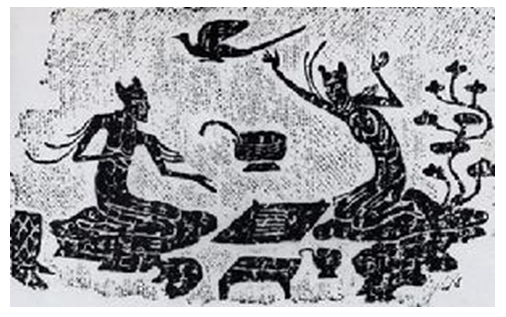 | Figure 17. Winged immortal playing Liubo (tomb engaving unearthed from Xinjing, Sichuan, Province) |
In the Han Dynasty images, the process of becoming immortal was very dramatic. A fresco of driving-car pulled by four birds to soar in the sky (Fig. 18), on one hand, showed very childish and simple imagination of entertainment, on the other hand, conveyed the Taoist idea of being immortal. As shown in fresco of Buqianqiu couple tomb (Fig. 19), there were immortal Wangziqiao (Prince Qiao), God Fuxi and Goddess Nüwa (the creators of human beings), anonymous fairies, as well as the clouds, the moon, the sun, dragon, and sheep, Rosefinch, white tiger, snake, yellow toad, rabbit, which were co-working to build a world of "dragon flying over clouds, snake skiing through fog". The mural focused on the characterization of the master being immortal. Buqianqiu the man drove snake with a bow in his arm, while his wife riding three-head birds with a three-legged crow held on her hand, these couple were soaring in the sky with their eyes closed. Once the connotation of being immortal was removed, the picture under the reader’s eyes was reduced to be a drawing of naive and crazy flight game, which couldn’t be really carried, without the aid of machinery, until modern times. Therefore, in the view of modern people, it was very ridiculous on one hand, but was extremely romantic on other hand. | Figure 18. Becoming immortal by driving wine-car pulled by four birds (tomb fresco unearthed from Hao Tan, Shaanxi, Province) |
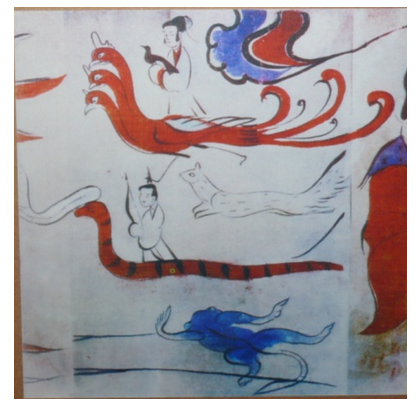 | Figure 19. Buqianqiu couple ascending heaven (tomb fresco unearthed from Luoyang, Henan, , Province) |
In the engraving of being immortal by driving deer sleigh (Fig. 20), the deers pulled cloud sleigh running through the clouds and fogs in a high speed. It conveyed the meaning of the deceased to be immortal. In the front of picture, the winged immortals flew with Linzi in his hands, the driver and the tomb owner sit in the sleigh, the charioteer grasped on habenula and wielded whip, after the sleigh two celestial beings chased deer with highly protruded horns, the winged immortal flew freely on the top of the horse. When modern people perceive the image at once, they are often attracted at the first glance by the connotation of being immortal, and will ignore the original recreational theme. With the removal of the winged immortal, the picture could be reduced to a normal driving game of deer sleigh. Maybe the Han Dynasty people had not been to the north pole, but the imaginary landscape in the image resembled somewhat the scene of deer sleigh at arctic circle. | Figure 20. Ascending heaven by deer sleigh (tomb engraving unearthed from Nanyang, Henan, Province) |
In the Han dynasty image, the ultimate destination of being immortal, i.e. the fairyland, was full of various recreational scenes referred in above paragraphs. Taking the fresco of boat shipping the celestial as example (Fig. 21), the deceased sat in a boat, and was oriented by the winged immortal to Mother Queen of the West, who sat up straightly and watched at the upper left corner of the picture. At the upper right corner two mortals chased the boat by driving the fish car, while at right side, with wine vessels put in the front, a bear plucking a zither-like instrument, and a tiger blowing a pipe, the other two tiger rising and dancing in a happy mood, two toads responding readily to music. The grass swayed, the dragon sported and fishes shuttled within the water. It was really a joyous scene! The Japanese scholar De Zhong had said that the foundation of immortal thought, which was a especial ideology, was the imagination for life extension without limitation and eternal enjoyment. Naturally, the picture led viewers to connect in the mind the scene of the Variety Show accompanied with feast at aquarium, however the white bear and yellow tiger may distracted viewers’ mind to other place as if in fairy mountain. Such sudden drift of thought occurred in watching the picture may result a dreamlike feeling.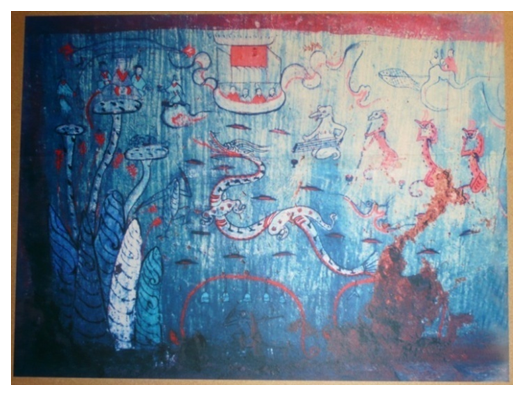 | Figure 21. Boat shiping the celestial (tomb fresco unearthed from Haotang, Shaanxi Province) |
6. Conclusions
The Han Dynasty image included various recreational scenes such as confrontational drama, athletics, Variety Shows, games, mental tournament, its expression style was either true portrayal or boldly artistic fiction. Different from the strong spiritual mould of the ancient Romans, the ethos of the Han Dynasty people was a combination of strength and flexibility, showing a dividing line between the Eastern and the Western hemisphere. Because most of the upper-class elites were born as civilian, who had various natural connections with common people, and various external cultures merged with the local culture, the people cultivated broad and inclusive spirits. In the Han Dynasty, the factors of social stability and economic booming promoted the development of recreational activities, and the peoples had enough time and money to enjoy leisurely and carefree lives. Under the Taoism influence, the peoples were fever for being immortal, they carried various practices to becoming immortals, and finally lost in the delusion of amusing themselves to death.
References
| [1] | Chen Yao, Ancient Roman Gladiator, Grand Garden of Science, 2009, 10. |
| [2] | Han Zhifang, Variation of gladiator in ancient Rome sports, Sports Culture Guide, 2004, 2. |
| [3] | Liu Hsin (the Western Han Dynasty), Miscellaneous Notes of the Western Capital (西京雜記), volume 3. |
| [4] | Chen Haihua, Humanities Knowledge and Sport Knowledge Represented by Han Period Pictorial Stone, Hebei Education Publishing House, April 2008, 1th Edition, Pg. 75. |
| [5] | Huang Jun, Chinese Ancient Horsemanship, Sports Culture Guide, 2003,12. |
| [6] | Fan Ye, the Book of the Later Han, Volume 49, Biography of Biographies of Wang Chong, Wang Fu, Zhongchang Tong (漢書 • 仲長統傳). |
| [7] | Hong Wei Zhong, On the Watching Qi of Han, Wei, Jin, North and South dynasties, Gansu Social Sciences, 2011, 2, 122-125. |
| [8] | On July 1958, when FIFA president Dr. Havelange arrived to China, he had said that football was originated from China; On February 2004, Jerome Champagne, deputy secretary-general of FIFA, claimed officially at a press conference in London: The earliest football is originated in China. |
| [9] | Wang Can (the Eastern Han Dynasty), Preface of the Ode to Game of Pitch-Pot (投壺賦序), Preface of the Ode to the game of go (圍碁賦序), Preface of the Ode to Tang Chess (彈碁賦序). |
| [10] | The History of LiuBo, CCTV International (16: 22, Feb 6th, 2005). |
| [11] | The Book of Rites · Game of Pitch-Pot (禮記 · 投壺). |
| [12] | Nie Jidong, Recreational Customs of the Scholars in Donghan Dynasty, Folklore Studies, 2008, 3, 209-219. |
| [13] | Campany, Robert Ford (2002). To Live As Long As Heaven and Earth: Ge Hong's Traditions of Divine Transcendents. University of California Press. ISBN 9780520230347. |
| [14] | Qin Dezhong, Taoism History, Shanghai Translation Publishing House, 1987, 55-56. |
| [15] | Chen Guang-Zhong, Liang Zong-Hua, Taoism and Chinese Philosophy, People's Publishing House, 2004 Edition, Pg. 9. |
| [16] | Gao Kai, Relationship between the doctrines of maintaining good health idea in ancient China and the longevity, Theory Learning, 2011, 1, 217-219. |
| [17] | Yang Yuhui, Comparison Between of Buddhism and Daoism in Humanism, Religious Studies, 2007, 1, 106-108. |
























 Abstract
Abstract Reference
Reference Full-Text PDF
Full-Text PDF Full-text HTML
Full-text HTML